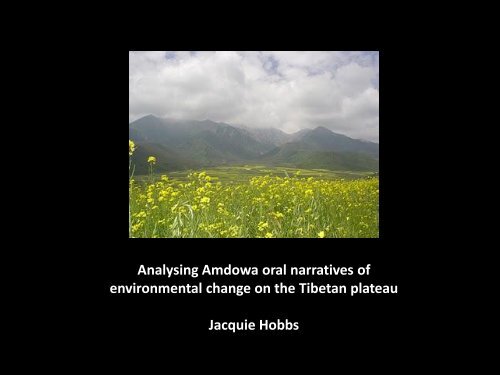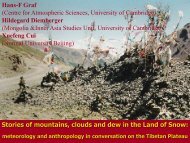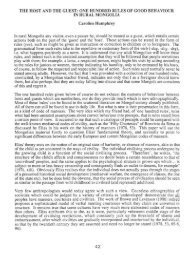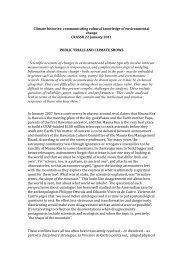Tibetan constructions of time - Climate Histories
Tibetan constructions of time - Climate Histories
Tibetan constructions of time - Climate Histories
- No tags were found...
Create successful ePaper yourself
Turn your PDF publications into a flip-book with our unique Google optimized e-Paper software.
Analysing Amdowa oral narratives <strong>of</strong>environmental change on the <strong>Tibetan</strong> plateauJacquie Hobbs
PhD thesis. “When theMilkbird comes”: Amdo-<strong>Tibetan</strong> <strong>constructions</strong> <strong>of</strong> <strong>time</strong>Nomads, Anye Machen area, May 28, 2008Abstract: “When the Milkbird comes, Amdo-<strong>Tibetan</strong>nomads in Qinghai province, PRC say their yak beginto give milk. These nomads frequently mention theMilkbird when they are asked about <strong>time</strong> and itsappearance is linked to the agricultural calendar.But this is only one <strong>time</strong>-reckoning system andthere are diverse Amdo-<strong>Tibetan</strong> <strong>constructions</strong> <strong>of</strong><strong>time</strong> to be found across today’s Amdo region. Whatis the nature <strong>of</strong> these <strong>constructions</strong> and how shouldwe interpret the Milkbird in relation to them? Thisthesis reveals in their use <strong>of</strong> <strong>time</strong>-reckoning devices,not just Amdowa inter-dependence with nature buttheir reactions to the hegemony <strong>of</strong> <strong>Tibetan</strong>Buddhism and to the political authority <strong>of</strong> bothimperial and modern China, including theirresponse to urgent economic pressures andenvironmental change. <strong>Tibetan</strong> <strong>time</strong>-reckoningsystems emerge as linked to the political – but onlyto the extent that they are anchored in localknowledge. This thesis suggests a new role for socialanthropology in light <strong>of</strong> a critical evaluation <strong>of</strong> thestatus <strong>of</strong> local knowledge <strong>of</strong> environmental change;partially challenges Gell's (1992) work on thepolitics <strong>of</strong> <strong>time</strong>; and introduces a new reading <strong>of</strong> the<strong>Tibetan</strong> calendar, based on the anthropology <strong>of</strong>Buddhism.”Amdo-<strong>Tibetan</strong> monks, nomads, farmers,urbanites, academics & studentsJan 2007 - May 2009Qinghai (& Gansu) province, PRC
12 fieldwork sites:(11 in Amdo)
The “gap”:• Nomads say they don’t use thecalendar, monks say they do• <strong>Tibetan</strong> calendar empiricallyinaccurate (Henning 2007)• Empirical observation <strong>of</strong> nature vs<strong>Tibetan</strong> Buddhist calendricaltradition using that observationTime is political (Gell 1992):• Preservation <strong>of</strong> identity <strong>of</strong>ten atexpense <strong>of</strong> need for accuracy• Tibet defines itself in relation toIndia, Mongolia & ChinaBut it’s also non-political:• Used knowledge-system <strong>of</strong> the<strong>Tibetan</strong> Buddhist 2 Truths tolegitimate any new calendarEven more political!• Any new, more, accurate <strong>time</strong>reckoningsystem assimilated• PLUS any challenge to <strong>Tibetan</strong>identity subsumedAmdo-<strong>Tibetan</strong> <strong>constructions</strong> <strong>of</strong> <strong>time</strong> …<strong>Tibetan</strong> calendars , <strong>Tibetan</strong> Medical Hospital, Lhasa, March 2oo8Reaction to the politico-religious1authority <strong>of</strong> <strong>Tibetan</strong> Buddhism
Imperial China:Amdo always closer to China than toLhasa where the <strong>Tibetan</strong> calendar(bod rtsis) is formulated• Used the 18 th century CE Chinese(Jesuit) calendar (rgya rtsis)• This calendar is highly accurateModern China:• But via <strong>Tibetan</strong> Buddhist 2 Truthsmake it <strong>Tibetan</strong>: the “Amdo calendar”• The Chinese calendar becomes theGregorian calendar or just the Chinesecalendar’s lunar or divinatory aspectThe “gap” underlies these:• <strong>Tibetan</strong> calendar is “accurate”,“scientific”, “spiritual”, “white”• Chinese calendar is “inaccurate,“backward”, “superstitious”, “black”Counter-hegemonic discourses:• Simultaneously contradict & assent(Ong 1997, Gaongkar 2001)• Enact ethnic authenticity & culturalAmdo-<strong>Tibetan</strong> <strong>constructions</strong> <strong>of</strong> <strong>time</strong> …Lo gsar, G Shongwa, Feb 1, 2008Reaction to the political authority <strong>of</strong>2superiority (White 1998)imperial and modern China
Mdzo rgan ra har nomadMay 16, 2008«Because the land is changing, the animalsare changing. They are thinner, less strong,there is no comparison between theanimals before and now. Winter is verycold. Last spring was much warmer andthe animals were stronger. But this springis longer and the animals are weakerbecause it is colder. Yes it’s not the sameas it was. The land is changing. The earth isbecoming smaller. It’s shrinking. It lookslike that. Going down to the valley before,the number <strong>of</strong> yak hasn’t changed butthey say 20 years ago all the sheep andyaks would go into the valley. … Now it’snarrower than before and the sheep andyak cannot enter. The land is drier. Theriver is disappearing. In the past accordingto the Chinese lunar calendar, in Aprilthere’s lots <strong>of</strong> baby yak and milk. Now thebaby yak cannot stand because they aretoo weak and because <strong>of</strong> the milk from thegrass.»
«Winter is very long. Also spring is long.Summer is short. Spring is late, notmuch spring. This month is supposed tobe the first <strong>of</strong> summer but it’s stillwinter or spring. The summer is colder.Before, this season was for shearing thesheep but now it’s too cold. There’s alot <strong>of</strong> snow, less rain. Even in summer itsnows. There’s strong wind and thetemperature is much lower. When I wasyoung, I never heard <strong>of</strong> there being notenough grass for animals but nowthousands <strong>of</strong> animals are dying fromstarvation. Before my father andgrandfather said that every <strong>time</strong> theyrode, the grass, the grass came up tothe belly <strong>of</strong> the horse. Their legs werealways wet and the children hid in thegrass, it was so thick. Now afterLiberation in 1958, the grass is hardlyover our shoes.»Chu khol ka nomadMay 17, 2008
Case study: The Milkbird«According to the lunar calendar it comes on May 1 st . It comesonce then goes away in mid July. The milk, the Milkbird bringsmilk. The nomads like the Milkbird. Our forefathers told us thatthis is the bird which brings milk to the nomad, that’s why webelieve in it.»The issue <strong>of</strong> reliability: “is it true?”[Amdo-<strong>Tibetan</strong> nomads say:]• It’s blue and white on theupper chest. It has a long tail.• The Milkbird is blue, withthin white colour.• The Milkbird is black andwhite, with a white head.• It’s small, blue and white.• The Milkbird is blue withwhite colour.• It has white shoulders.• It has a white head.Siberian blue robin?Oriental magpie robin?Slaty-blue flycatcher?Grandala?
All Milkbird data excluded:• Milkbird probably doesn’t exist• If it does, it’s the Grandala• Evidence not empirically verifiableAll verifiable cultural data excluded:• Qualitative data did not meet therequirements & focus <strong>of</strong> the studyMethodological questions:• What makes verifiable cultural knowledgeauthoritative?• Why doesn’t reliable qualitative data basedon cultural knowledge get used?• What types <strong>of</strong> qualitative data based oncultural knowledge get used and why?• What gives that data “status” & whatdoesn’t?• Why don’t interested recipients <strong>of</strong> verifiabledata based on cultural knowledge still notengage with it?The role <strong>of</strong> social anthropology:• Communicating & explaining to scientistshow and why science is narrative/theempirical requires interpretation• Helping scientists who appreciate science isnarrative, to make the link practical• Advocacy <strong>of</strong> inter-disciplinary educationThe issue <strong>of</strong> take-up: from thereliable to the qualitative to …“what happened?!!”“You’ve been really useful, like …so helpful, though I still can’treally see what place socialanthropology has, in science … ”







